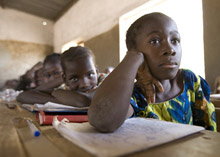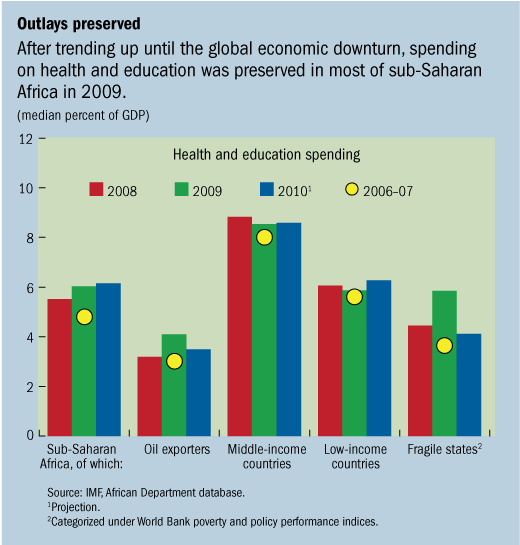
Typical street scene in Santa Ana, El Salvador. (Photo: iStock)
IMF Survey: Africa Sustains Social Spending Despite Downturn
April 23, 2010
- Health, education spending was trending up until global downturn effects hit
- Early data show social outlays were preserved in most countries in 2009
- Fiscal deficits rose last year in most countries in region showing slower growth
Higher spending on health and education in sub-Saharan Africa before the global economic crisis was sustained in 2009 despite the effects of the world downturn, an IMF report said.

School in Libreville, Gabon: sub-Saharan Africa’s health, education spending growth was robust in 2009 except for middle-income countries (IMF photo)
REGIONAL ECONOMIC OUTLOOK
The IMF’s Regional Economic Outlook for sub-Saharan Africa said early figures showed that last year median spending on health and education was above 2006–07 levels for all country groups—and especially for fragile states, which sharply increased their outlays.
The report said emphasis on public investment and health and education spending increased in 2009 across oil exporters, low-income countries, and fragile states. However, in middle-income countries median health and education spending lost some ground in 2009, although public investment levels were generally stable.
A major concern in most sub-Saharan African countries previously was the tendency to cut pro-growth and pro-poor spending at times of budgetary pressure. In most of the sub-continent’s countries, spending on health and education was trending up until the effects of the global downturn hit.
Rising trend
Health and education spending averaged about 5½ percent of GDP in 2006–07 and rose to about 7 percent in 2008—accounting for almost one-third of all primary spending in the region. Middle-income countries spent the most on health and education in 2006–07 at about 8 percent of GDP, and oil exporters spent the least at less than 3 percent of GDP. And it appears that outlays on health and education were preserved in most countries in 2009 (see chart).

Health and education spending in sub-Saharan Africa’s fragile states as a percentage of GDP is now in line with low-income countries. Except for middle-income countries in 2009, real growth rates of health and education spending in the region have been quite robust.
A growing number of countries in sub-Saharan Africa also have programs designed to provide social protection in bad times and social promotion in good times. A handful of African countries have successfully established poverty-related cash transfer programs, and many others are taking note of the modest cost and relative effectiveness of such programs.
The report says a priority for regional governments will be to preserve the sense of urgency to strengthen social safety nets in Africa after growth resumes, so that Africans can be better protected when the next shock comes their way.
Based on budgets and outturns, the fiscal policy intention seems clear: ramp up public investment and protect health and education spending. However, keeping health and education spending in line with the trend before the crisis will be a test for policymakers.
Budgets to counter slowdown
The report also noted that in formulating their 2009 budgets, about half of sub-Saharan Africa’s countries expected economic growth to fall below average growth rates posted during 2003–07. To counter the slowdown in growth, several of them planned to respond countercyclically, mostly through spending increases. Where spending plans did not increase, it was mainly due to concerns about macroeconomic stability and financing constraints, including aid disbursements.
In 2009, fiscal deficits increased in two-thirds of the countries in the region experiencing a slowdown in growth, largely because of discretionary spending increases beyond medium-term trends. This mostly reflects the stronger fiscal positions in most countries heading into the crisis, and the availability of additional external financing. In several countries, continued macroeconomic imbalances made it difficult to implement countercyclical policies even as the anticipated slowdown materialized.







